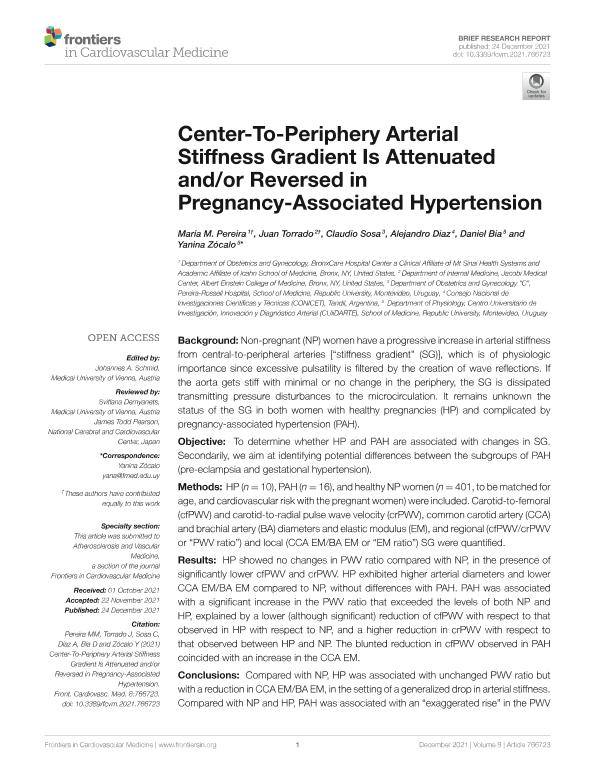Artículo
Center-to-periphery arterial stiffness gradient is attenuated and/or reversed in pregnancy-associated hypertension
Pereira, María M.; Torrado, Juan; Sosa, Claudio; Diaz, Alberto Alejandro ; Bia, Daniel; Zócalo, Yanina
; Bia, Daniel; Zócalo, Yanina
 ; Bia, Daniel; Zócalo, Yanina
; Bia, Daniel; Zócalo, Yanina
Fecha de publicación:
12/2021
Editorial:
Frontiers Media
Revista:
Frontiers in Cardiovascular Medicine
e-ISSN:
2297-055X
Idioma:
Inglés
Tipo de recurso:
Artículo publicado
Clasificación temática:
Resumen
Background: Non-pregnant (NP) women have a progressive increase in arterial stiffness from central-to-peripheral arteries [“stiffness gradient” (SG)], which is of physiologic importance since excessive pulsatility is filtered by the creation of wave reflections. If the aorta gets stiff with minimal or no change in the periphery, the SG is dissipated transmitting pressure disturbances to the microcirculation. It remains unknown the status of the SG in both women with healthy pregnancies (HP) and complicated by pregnancy-associated hypertension (PAH). Objective: To determine whether HP and PAH are associated with changes in SG. Secondarily, we aim at identifying potential differences between the subgroups of PAH (pre-eclampsia and gestational hypertension). Methods: HP (n = 10), PAH (n = 16), and healthy NP women (n = 401, to be matched for age, and cardiovascular risk with the pregnant women) were included. Carotid-to-femoral (cfPWV) and carotid-to-radial pulse wave velocity (crPWV), common carotid artery (CCA) and brachial artery (BA) diameters and elastic modulus (EM), and regional (cfPWV/crPWV or “PWV ratio”) and local (CCA EM/BA EM or “EM ratio”) SG were quantified. Results: HP showed no changes in PWV ratio compared with NP, in the presence of significantly lower cfPWV and crPWV. HP exhibited higher arterial diameters and lower CCA EM/BA EM compared to NP, without differences with PAH. PAH was associated with a significant increase in the PWV ratio that exceeded the levels of both NP and HP, explained by a lower (although significant) reduction of cfPWV with respect to that observed in HP with respect to NP, and a higher reduction in crPWV with respect to that observed between HP and NP. The blunted reduction in cfPWV observed in PAH coincided with an increase in the CCA EM. Conclusions: Compared with NP, HP was associated with unchanged PWV ratio but with a reduction in CCA EM/BA EM, in the setting of a generalized drop in arterial stiffness. Compared with NP and HP, PAH was associated with an “exaggerated rise” in the PWV ratio without changes in CCA EM/BA EM, in the setting of a blunt reduction in cfPWV but exaggerated crPWV drop. The SG attenuation/reversal in PAH was mainly driven by pre-eclampsia.
Palabras clave:
STIFFNESS
,
GRADIENT
,
PREGNANCY
,
HYPERTENSION
Archivos asociados
Licencia
Identificadores
Colecciones
Articulos(CCT - TANDIL)
Articulos de CTRO CIENTIFICO TECNOLOGICO CONICET - TANDIL
Articulos de CTRO CIENTIFICO TECNOLOGICO CONICET - TANDIL
Citación
Pereira, María M.; Torrado, Juan; Sosa, Claudio; Diaz, Alberto Alejandro; Bia, Daniel; et al.; Center-to-periphery arterial stiffness gradient is attenuated and/or reversed in pregnancy-associated hypertension; Frontiers Media; Frontiers in Cardiovascular Medicine; 8; 12-2021; 1-11
Compartir
Altmétricas



